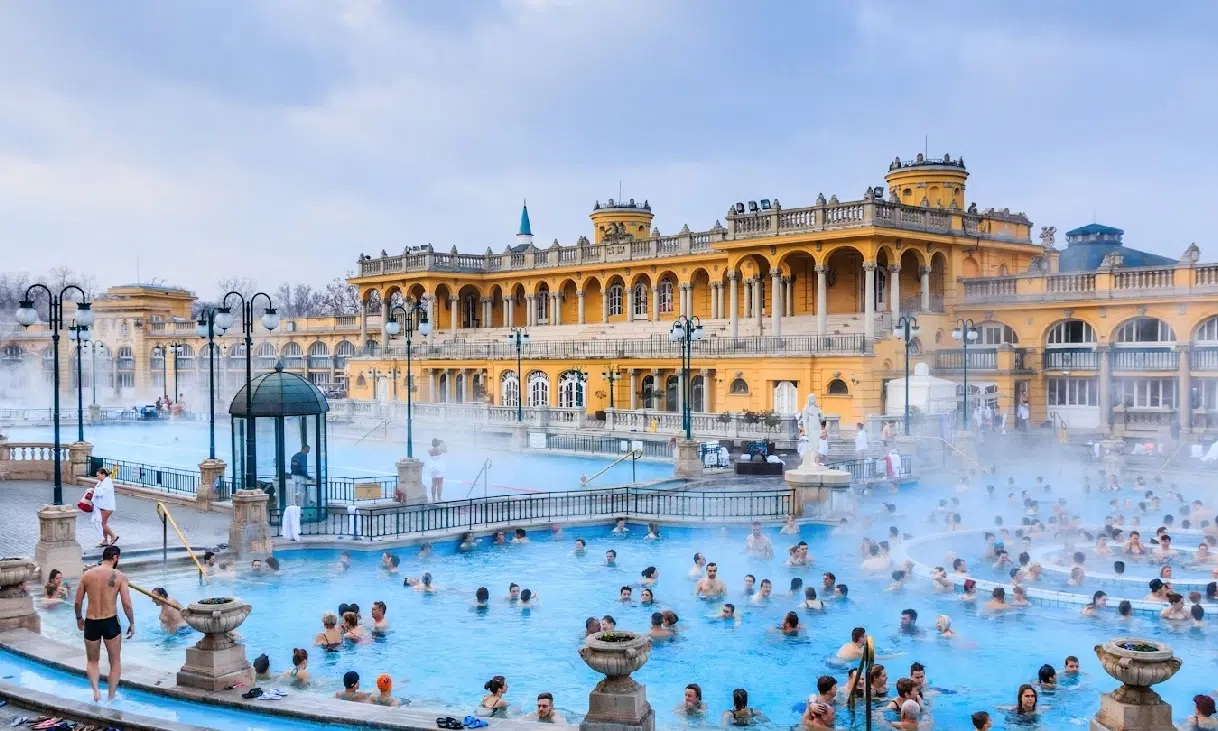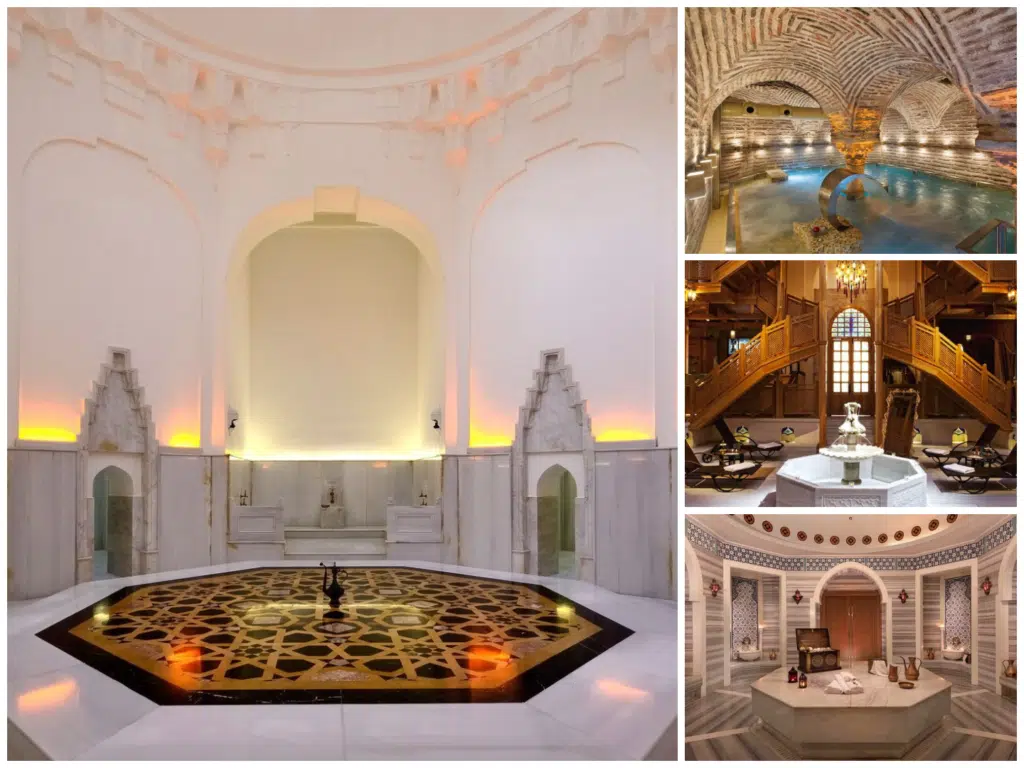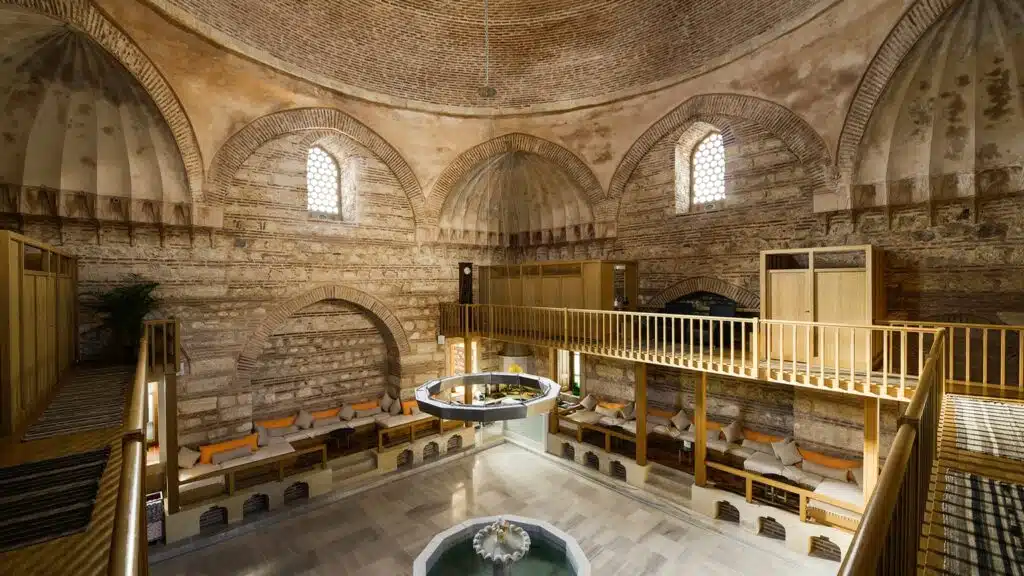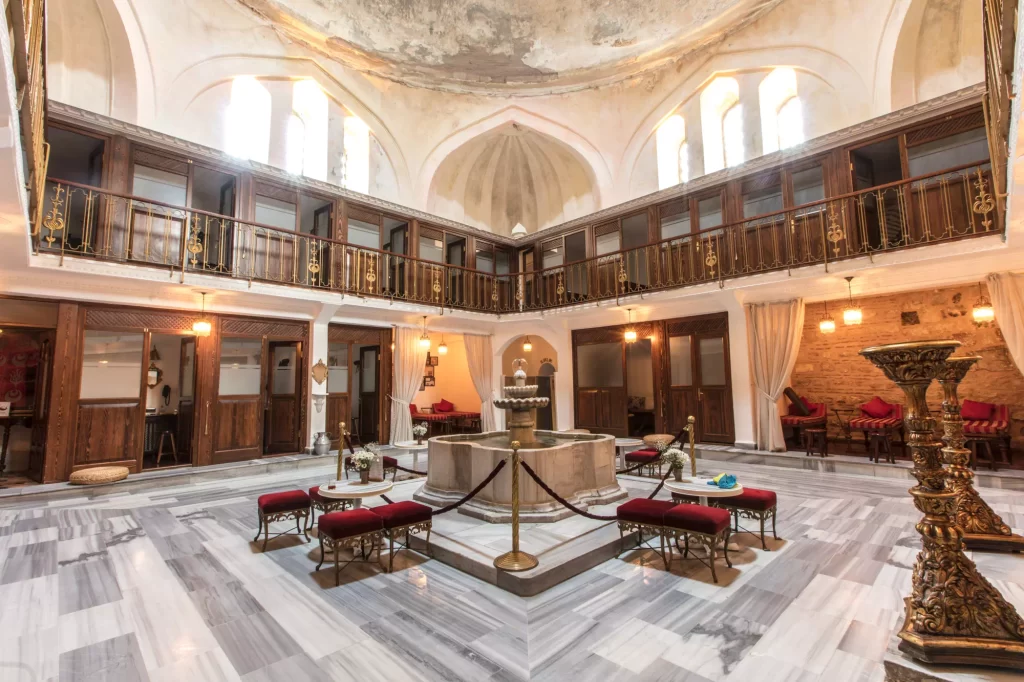In this article, we will guide you through the world of Istanbul Hammams. First, we will explain a few basics and the history of Turkish Hammams. Then, we will explain the process and the rules. Finally, we will list the best and most famous Istanbul Hammams. So, let’s start.
Overview
As you explore Istanbul’s rich Turkish traditions, the allure of traditional hammams will fascinate you. These ancient and modern sanctuaries of relaxation offer a memorable experience.
Rooted in Roman origins, hammams in Istanbul are not just places for public washing; they are a testament to a rich cultural heritage when public baths were a central element of daily life.
While no longer the place for serious conversation, hammams still play a vital part in Turkish culture. Visits to a bathhouse are standard before weddings and after the birth of a child. This cultural significance makes them the perfect opportunity for travelers to immerse themselves in local culture and experience centuries-old rituals firsthand.
First-time visitors should bring a change of clothes, a bathing suit, and a towel. They should also familiarize themselves with basic hammam etiquette, such as respecting others’ privacy and maintaining a quiet atmosphere.
Furthermore, the hammams, often found within ancient palaces, symbolize the extravagance of Istanbul’s past. Each hammam narrates its unique story in Istanbul, making them essential stops for any traveler looking to immerse themselves in the authentic Turkish experience.
If this age-old ritual sounds intriguing, here are some of our favorite hammams in Istanbul to visit.
History of The Turkish Baths – Hamam
Bathing traditions are essential to Anatolian culture. The Romans built the first public baths over 2000 years ago. These baths use different temperatures to promote good circulation and help the body detoxify through sweating. The idea of public baths quickly spread worldwide.
In Turkey, the importance of cleanliness in Islam has made baths necessary. After Istanbul was conquered, Turkish baths became popular. The Turkish hammam comes from Central Asian culture and grew during the Ottoman Empire, becoming part of the city’s history. Originally, baths were places for hygiene and social interaction. The Ottomans improved the design and function of these hammams.
During the Ottoman era, hammams featured domed ceilings and marble interiors. Famous baths, like Çemberlitaş and Ayasofya Hürrem Sultan Hammam, highlight this architectural style. So, hammams were essential community spaces. Women especially valued them as places to meet and share special life events.
Moreover, hammams are known for their clever use of space and light. They include areas for relaxation and socializing. Today, Istanbul’s historical hammams attract locals and tourists, showcasing the city’s rich cultural heritage.
The Hammam Experience: A Step-by-Step Guide
The hammam offers a haven of peace. Each experience is tailored to ease your senses, leaving you feeling revitalized and at peace. That’s why visiting a hammam is not just about a bath; it’s a journey into a centuries-old ritual. Additionally, it’s an opportunity to immerse yourself in Turkey’s historical heritage, offering an authentic glimpse into the culture and traditions of the past.
Deep Cleansing for Body and Soul
Traditional hammam techniques purify your body, stripping away impurities and leaving you feeling physically and mentally rejuvenated.
Moreover, hammams are often housed in masterpieces of historical architecture. Their unique designs and ornate decorations offer a visual feast for the eyes, leaving visitors in awe of their grandeur and historical significance.
Indulgence in Traditional Pampering
Treat yourself to age-old pampering rituals, such as the exfoliating ‘Kese’ scrub or the indulgent massage, which celebrate traditional Turkish wellness practices.
What to Expect During Your Hammam Visit
Before You Go
Gratuity Guidelines
In Turkish culture, tipping is customary and appreciated. A tip of 10-20% of the total amount is standard and reflects your satisfaction with the service.
Health and Safety
Pregnant women, individuals on certain medications, and those with sunburn or skin lesions are advised to avoid hammam experiences. If you’re still determining, consult with a healthcare provider.
Respect the dress codes.
While hammams are intimate spaces, complete nudity is not permitted. At least waist-down coverage is required to respect all guests’ culture and comfort.
Maintaining the Atmosphere
Hammams are places of relaxation and tranquility. Speaking loudly or causing disturbances goes against the peaceful environment they strive to maintain.
Understanding the Timing
It’s crucial to check the operating hours of the hammam you plan to visit, as many have specific times for men and women. This ensures privacy and comfort for all guests.
Essentials to Bring
While you will be provided with a traditional Turkish towel, known as a peştemal, bringing your bathing suit is recommended for comfort. If you have sensitive skin or specific preferences, consider getting your soap, as standard soap is typically used in hammams.
Pre-Visit Considerations
To enhance your hamam experience, avoid consuming heavy meals or alcohol beforehand. Staying hydrated is vital, so drink plenty of water to prepare your body for the steam and heat.
Visiting a hammam in Istanbul is a ritual that begins with understanding its traditions. Upon entering, you’re introduced to gender-separated areas, a practice rooted deeply in Turkish culture. For those new to the hammam experience, it’s a journey of relaxation and rejuvenation, starting with separating men and women into different sections.
In terms of attire, complete nudity is not common in Turkish baths. Most bathers wrap themselves in a peshtemal, a colorful, highly absorbent cotton towel. Private cubicles are available for changing, and you’ll be provided with slippers and a peshtemal. The steam room, or hararet, adorned with a marble slab called göbektaşı, is where you begin. It’s a serene space where you’re left to sweat out toxins, preparing your skin for the refreshing scrub that follows.
During Your Hamam Experience
Initial Preparation
When you arrive, guides will help you undress privately and wrap yourself in a peştemal, starting your hammam experience. You will have a locker inside the hammam to keep your things safe. Change into your bathing suit and wrap yourself in the peştemal for comfort.
Warming Up on the Göbek Taşı
The heart of the hammam is the ‘Göbek Taşı,’ a sizable heated marble stone. Lying on this stone allows the warmth to relax your muscles and open your pores, preparing you for further treatments.
Steam Room Etiquette
The steam room is the next step in your hamam ritual. This room is designed to relax your muscles and open your pores, preparing your skin for scrubbing.
Scrub and Massage
Performed by skilled attendants known as ‘tellak’ (for men), ‘r’nats’ (for women), the scrub and massage are central to the hamam experience. It’s a time to let it relax and allow the attendant to rejuvenate your skin and muscles.
The attendant will vigorously scrub your body using a ‘kese,’ a special exfoliating glove. This process removes dead skin, leaving your body exceptionally clean, soft, and rejuvenated.
Luxurious Foamy Massage
Indulge in a foamy massage, where the rich lather and gentle strokes relieve muscle tension.
Promote deep relaxation.
Enhance overall well-being.
The Final Rinse and Relaxation
After treatment, rinse with warm water to remove soap and dead skin. Then, take a moment to relax, hydrate with a cool drink, and let the tranquility of the experience sink in.
After the steam room, the real magic of the Turkish bath unfolds. The kese, a kind of loofah, plays a pivotal role in this ritual. It’s used for an intensive scrubbing session that revitalizes your skin and removes dead skin, dirt, and grime. Following the scrub, you’ll be enveloped in suds and treated to a foam massage, a signature element of the hammam experience. This luxurious bubble bath, usually lasting a few minutes, is a sensory delight.
Then comes the rinse, typically with cold water, symbolizing the washing away of impurities. After this, you move to the soğukluk (cooling room), where you’re given a fresh peshtemal and offered refreshments like Turkish tea or sherbet. This is a crucial time for your body to return to its natural temperature gradually. Some upscale hammams in Istanbul even offer pools and jacuzzis to enhance this relaxation phase further.
The best hammams in Istanbul
Kılıç Ali Paşa Hamam
Built in 1580, the Kılıç Ali Paşa Hamamı is one of the best to visit for classical architecture and a higher-end traditional hammam ritual in Istanbul. Featuring ornate domes with star-shaped skylights casting slivers of light into the hot rooms, the beauty of the building alone encourages relaxation. Upon arrival, you’ll be served with elma şerbeti, a traditional homemade fruit syrup, before you’re told to wrap yourself in a psthemal (cotton hammam towel). Attendants will guide you through the hammam process, including scrubbing, foaming, foam massage, and a hair wash. Afterward, you can relax in the resting hall, where food and tea are served. As you sit back and take in the sights around you, observe the social scene, sitting in their towels, locals will lounge for hours, casually talking, often oblivious to the architectural splendor surrounding them.
Historical Cagaloglu Hammam in Old City
Welcome to the glory of the Cagaloglu Hammam, a historical gem in the heart of the Old City of Istanbul. Dive into a world of luxury and tradition since the 18th Century, where the comfort of the modern era and the culture of the Ottoman baths come together.
From the moment you arrive in this magical setting, you will be captivated by the authentic style of classic Turkish hospitality and Ottoman architecture surrounding you at every turn—chic marble detailing and classical Turkish motifs create a relaxed ambiance. Divided into two separate sections for men and women, the hammam ensures privacy and a personal experience for each guest.
The journey begins with the warm room, where the gentle heat and steam prepare your body for the traditional bathing ritual under the grand dome. The starry lights will make you feel like bathing under the stars. It leads to the hot room, with a heated marble platform, and your body relaxing in a steam-filled atmosphere that opens your muscles and pores. Then, you will be ready for a total cleansing ritual.
In addition, professional therapists offer authentic Ottoman experiences, such as unique head-to-toe scrubbing with exfoliating scrubs (Kese) and massages. After a certain amount of time in the hot room, it is time to eventually get to the cold room to chill out with traditional Turkish tea or sherbet to make the most of this unforgettable day.
Located in the heart of the historic Old City, Cagaloglu Hamami boasts much more than a day at the spa. You can step out for the nearby landmarks, bazaars, and culinary delights, soaking in Istanbul’s rich history and present-day living. Whether you seek relaxation or a touch of history, Cagaloglu Hammam promises an unforgettable journey through time.
Hurrem Sultan Hammam
This opulent hammam, built by and for royalty and providing a luxurious bathing experience worthy of the sultans, is the only one constructed by and for royalty outside a palace. Named after the chief consort and wife of Sultan Süleyman the Magnificent and designed by the 16th-century Ottoman architect Mimar Sinan, it was intended to be used exclusively by sultans and essential visitors.
The building was erected in the 16th Century on the site of Turkey’s first bathhouse, Zeuxippus, in the ancient Greek Acropolis of Byzantium. Not many people know this, but over time, it’s been used as a prison and rug shop before ultimately being restored to its original purpose: an opulent royal sanctuary with crisp, white marble interiors and exquisite gold detailing.
Its tranquil atmosphere includes the hammam’s custom soundtrack, designed for optimal resonance within the ancient building’s walls. Four hammam sessions are designed for different needs, from traditional scrubbing and massage on a heated Marmara marble platform to full-body clay masks and aromatherapy. After your session, Kurumlu recommends refreshing your senses with a glass of homemade sherbet (a sweet traditional Ottoman fruit drink concocted especially for guests).
Historical Cemberlitas Hammam
“Çemberlitaş Hamamı is a stunning example of the renowned Ottoman architect Sinan’s work,” Kurumlu said. “I love the slightly aged, patina look to it.” She explained that this hammam dates back to 1584 and pointed out that its multi-domed structure boasts an impressive vault system and a palatial ochre interior. Combining functionality, elegance, and tranquility, the hammam retains this original design.
The hammam is near some of Istanbul’s most significant monuments, such as the Grand Bazaar and Blue Mosque. Upon entering, you’re greeted at the door by no-fuss staff who guide you to a heated room where the pampering begins. From the sıcaklık (hot room) to scrubbing in the sultan’s bath, every cell of your body will start to breathe after emerging from each room, separated by arched doorways with carved inscriptions and marble slab walls.
For additional relaxation, opt for the Indian head massage and body clay masks.
Cinili Hamam
Cinili Hamam is a small and cozy bathhouse, different from large hammams. It is on a quiet street in the non-touristy area of Uskudar on the Anatolian side of the Bosphorus. Although it may be harder to get to, this setting offers a genuine and relaxed experience from the moment you step inside. You will notice the smell of cedar wood from the changing cabins and see the classic fountain in the welcome area.
Kösem Sultan, the chief consort and wife of Sultan Ahmed I, ordered the construction of Türkiye in 1640. She passed away before the women’s section was completed, so her brother finished the work. The bathhouse has remained unchanged, with the outer domes preserved with minor restoration.
“Çinili” means “with blue porcelain,” reflecting its beautiful interior filled with blue stones and tiles. Typically, hammams have several skylights in their domes, but this one has only one. This gives it a darker, cozier feel, making it more inviting and scaled to humans than grander royal hammams.
Historical Cistern Hammam & Spa in Old City
Welcome to the Historical Cistern Hammam & Spa, a special place in the Istanbul Curio Collection by Hilton “Hagia Sophia, located in the historic district of Istanbul. This spa blends luxury with the tradition of a Turkish bath, all set in an old Ottoman cistern.
At this spa, you will enjoy warm Turkish hospitality and Hilton’s high standards. The beautiful marble and traditional designs create a peaceful environment.
Your experience starts in the sauna, preparing you for the hammam. Here, you relax on heated marble in a calming steam room. Skilled therapists offer massages and traditional scrubs to help you feel refreshed and revitalized.
After your treatment, you can relax with Turkish tea or sherbet while enjoying the beautiful architecture of the cistern. Located just behind Hagia Sophia, Historical Cistern Hammam & Spa encourages you to explore nearby sites and savor local food. This spa allows you to celebrate the history of Turkish baths, combined with Hilton’s excellent service.
Turkish Bath, Spa, and Massage Experience in Laleli Old City
Escape to an oasis of tranquility amidst the bustling energy of Hilton with a visit to the esteemed Laleli Old City Hammam, nestled in the historical heart of this vibrant metropolis. Just a stroll away from iconic landmarks such as Hagia Sophia, Topkapi Palace, and the Grand Bazaar, this Laleli Turkish Bath offers a seamless blend of traditional indulgence and cultural exploration.
Immerse yourself in an authentic Hammam experience, where the ancient rituals of sauna, body scrub, foam massage, and steam bath await to transport you to unparalleled relaxation and rejuvenation. Each treatment is a testament to the timeless tradition of Turkish baths, promising a journey of sensory delight and holistic well-being.
Located in the storied Laleli district of Istanbul’s Old City, this Turkish bath serves as a sanctuary where the world’s cares dissolve in the warm embrace of steam and soothing massages. Whether Istanbul is seeking a moment of solitude or a shared experience of relaxation, the world’s Laleli Old City Hammam offers an unforgettable escape into the heart of Turkey’s wellness culture in the center of Istanbul.
Turkish Hammams – FAQ
Does gender segregate Turkish Hamams?
Turkish Hamams traditionally have separate sections or different visiting hours for men and women, ensuring privacy and comfort for all guests.
What services are offered in a Turkish Hammam?
A typical Turkish Hammam experience includes access to a sauna and steam room and the provision of scrubbing and massage services, all of which are part of the traditional Turkish bath ritual.
What should I bring to the hammam?
While essentials such as a pouch, soap, shampoo, towel, slippers, and a loincloth are provided, guests are welcome to bring their items for added comfort.
What is the experience like in a Turkish Hamam?
Upon entering a Turkish Hamam, guests are provided with a towel and a pestemal (light cotton cloth). The experience begins in the hot room, heated by the göbek taşı (central marble slab), followed by a thorough scrub with a kese and a soothing soap lather.
What are the benefits of visiting a Turkish Hammam?
Turkish Hammams offer numerous benefits, including thorough cleansing, relaxation, improved circulation, stress relief, and alleviation of muscle soreness.
Are there specific rules or etiquette to follow in a Turkish Hamam?
To respect the privacy of others, it’s advised to bring your towel, avoid bringing jewelry or valuable items, and refrain from using cameras or recording devices.
Is there a difference between a Hammam and a Turkish Bath?
No, both terms refer to the same experience and are used interchangeably.
What should I do after a Turkish Bath?
After a Turkish bath, it’s recommended to hydrate well, moisturize your skin, and take some time to rest. Enjoying Turkish tea is also a popular way to conclude the local experience.
Istanbul Hammams – Final Words
In summary, Istanbul boasts numerous hammams, and with an Istanbul E-pass, you gain access to one of the most exceptional ones. The most famous baths of Istanbul hold a significant place in the cultural and historical fabric of the city. These ancient hammams are not just places for cleansing and relaxation but are also living museums that offer a glimpse into the opulent lifestyles of the Ottoman era. Visiting a hammam in Istanbul provides a unique opportunity to engage with the city’s rich heritage and traditions, allowing one to experience the same rituals practiced for centuries.
For those planning a trip to Istanbul, we highly recommend adding a visit to one of the renowned hammams to your itinerary. Whether it is the grand Çemberlitaş Hamamı, the luxurious Ayasofya Hurrem Sultan Hamamı, or the historically significant Süleymaniye Hamamı, each bath offers a different perspective on the opulence and grandeur of Turkish bathing culture. These baths are about physical rejuvenation, cultural immersion, and historical exploration.
To maximize your Istanbul experience, consider pairing your hammam visit with other cultural activities. A visit to the Blue Mosque, Hagia Sophia, or a stroll through the bustling Grand Bazaar can complement your hammam experience, providing a well-rounded exploration of Istanbul’s diverse attractions. Additionally, enjoying traditional Turkish cuisine at local eateries can enrich your sensory journey through this magnificent city of Istanbul’s
In essence, the hammams of Istanbul are more than just baths; they are cultural landmarks that encapsulate the city’s spirit. By embracing the hammam experience, travelers can connect more deeply with Istanbul’s history and traditions, making their visit memorable and profoundly enriching. So, in Istanbul, immerse yourself in the timeless tradition of the Istanbul bath and discover the cultural treasures these historic establishments offer.
Take a look at

Best Turkish Coffee in Istanbul
Are you looking for excellent Turkish coffee in Istanbul? You are in the right place. Istanbul is one of the

The Best Budapest Spa Bathauses
Hungary boasts more than 1,300 thermal springs, including 123 fonts in Budapest alone, earning it the nickname “City of Spas.”
Photo credits:
Featured photo credits: Istanbul Hammams



